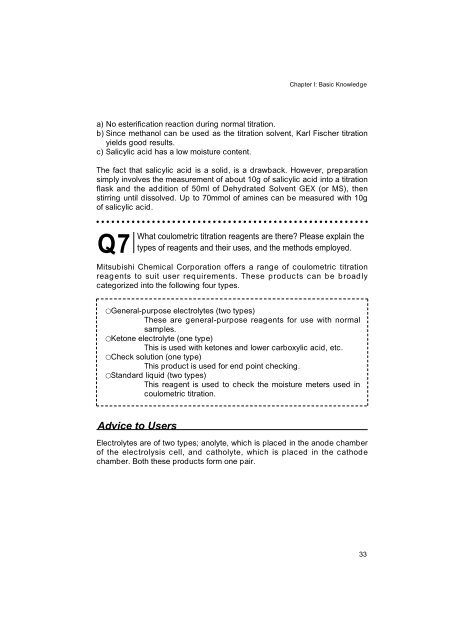Development of Karl Fischer Reagents
Development of Karl Fischer Reagents
Development of Karl Fischer Reagents
You also want an ePaper? Increase the reach of your titles
YUMPU automatically turns print PDFs into web optimized ePapers that Google loves.
Chapter I: Basic Knowledge<br />
a) No esterification reaction during normal titration.<br />
b) Since methanol can be used as the titration solvent, <strong>Karl</strong> <strong>Fischer</strong> titration<br />
yields good results.<br />
c) Salicylic acid has a low moisture content.<br />
The fact that salicylic acid is a solid, is a drawback. However, preparation<br />
simply involves the measurement <strong>of</strong> about 10g <strong>of</strong> salicylic acid into a titration<br />
flask and the addition <strong>of</strong> 50ml <strong>of</strong> Dehydrated Solvent GEX (or MS), then<br />
stirring until dissolved. Up to 70mmol <strong>of</strong> amines can be measured with 10g<br />
<strong>of</strong> salicylic acid.<br />
Q7<br />
What coulometric titration reagents are there? Please explain the<br />
types <strong>of</strong> reagents and their uses, and the methods employed.<br />
Mitsubishi Chemical Corporation <strong>of</strong>fers a range <strong>of</strong> coulometric titration<br />
reagents to suit user requirements. These products can be broadly<br />
categorized into the following four types.<br />
�General-purpose electrolytes (two types)<br />
These are general-purpose reagents for use with normal<br />
samples.<br />
�Ketone electrolyte (one type)<br />
This is used with ketones and lower carboxylic acid, etc.<br />
�Check solution (one type)<br />
This product is used for end point checking.<br />
�Standard liquid (two types)<br />
This reagent is used to check the moisture meters used in<br />
coulometric titration.<br />
Advice to Users<br />
Electrolytes are <strong>of</strong> two types; anolyte, which is placed in the anode chamber<br />
<strong>of</strong> the electrolysis cell, and catholyte, which is placed in the cathode<br />
chamber. Both these products form one pair.<br />
33




